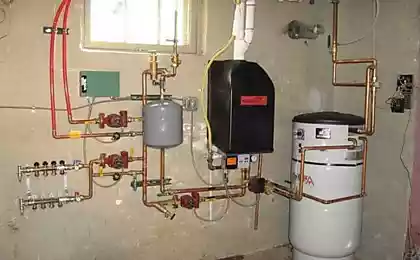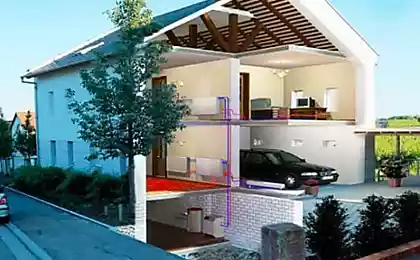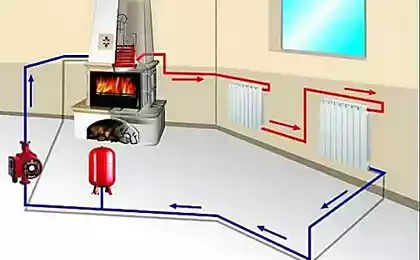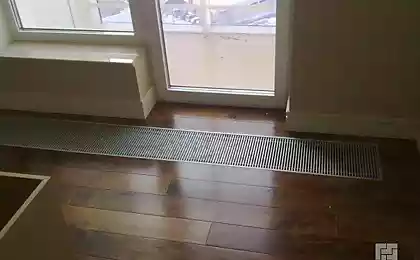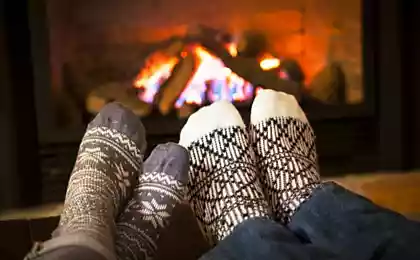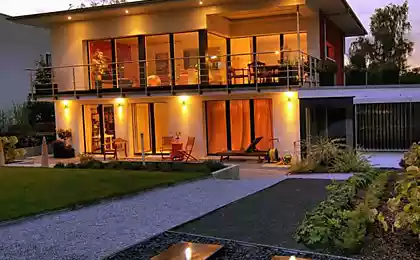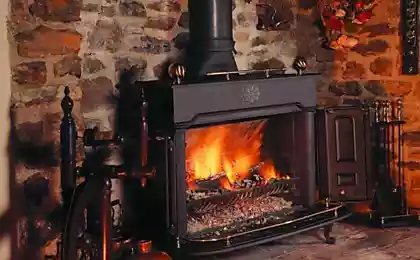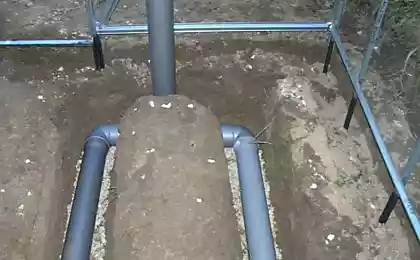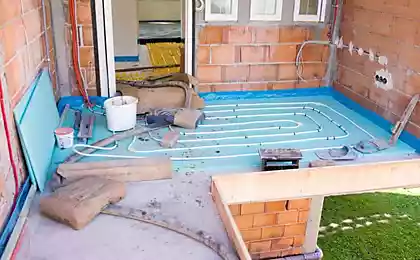697
How to make Korean ondol warm floor
Ondol is a Korean Underfloor heating. How to build it? This question is asked by many people who would like to make an economical, simple and at the same time interesting and original warm floors at home as a heating system for a cottage or apartment. Let's try to answer this question. And to start to define the terms.
Ninety four million eight hundred sixty three thousand nineteen
Thus, the ondol is NOT a warm floor in our European understanding
Due to the fact that traditional Korean warm floor do not go and lie on it, sit, perform manual work — ondol closest to the stove Russian stove. Only huge and more effectively designed (with more than stove efficiency). But as already established, the phrase "ondol = heated floor in Korea," we will not break tradition, and will continue to use this combination. Look at the ondol read more:
The word "ondol" is borrowed from Chinese language and means "warm-cavity". So before such things were in China (and maybe still is). So homeland ondol in China. Where the system was adopted by the Koreans. On the other hand, there is an alternative point of view: the Korean Peninsula heating system used to be called — gudel (Gudeul, 온돌), the name comes from the Korean guun-dol, which means "warm stone" and only in the late NINETEENTH century Korean literature to denote the floor started to use the Chinese term "ondol". In General, the origin of the name — it is dark. The first secret warm ondol floor is to design the floor. Before doing the floor, Koreans laid tunnels for hot smoke (square cap with parallel channels with inlet and outlet on opposite sides). On top of the tunnels put thin flat stones with a thickness of five to seven centimeters. In close proximity to ovens used stones thicker. The stones were covered with a layer of yellow clay, which is then carefully leveled. In the end, the floor was pasted with several layers of yellow oiled paper (in order to maximize the sealing flues)
In Ancient Rome, like heated floors called gipokaliemicakie — over-burning (hence the origin of the name "caustic soda" caustic soda). So if you to find anywhere the phrase Hypocaust — that will know what we are talking about warm floors in Ancient Rome.
Incidentally, in Japan, apparently, also used a similar system. For example, in Miyazaki cartoon "My neighbor Totoro" can be regarded that the bathroom ofuro (discussed in more detail in the article "Peculiarities of the Japanese bath-OFURO bath") in the house, where the family settled the protagonist, bottom heated with warm air (you can see the damper from firebox and chimney outside the window). Who hasn't watched the cartoon look, very sincere. And who saw — can review. And get fun, and something new to see.But back to andali:
The second secret to a good warm ondol floor in the middle. On the one hand, to maintain in a furnace the fire, the smoke should pass quickly through the tunnels and out freely up the chimney (should be sufficient draught). It is better suited direct short tunnels. On the other hand, so that the heat went on a heated floor, you have as long as possible to keep him in the tunnels. A good combination of both (plus water) gives excellent ondol, which will benefit both children and grandchildren and great-grandchildren.
Another important aspect of a good pull-high pipe. The higher the pipe, the higher the pressure drop, and the better traction. But this applies not only to warm the floor, but also to such pieces as the fireplace, furnace and other places. We illustrate these points drawing: by the Way, in order that the smoke went through the ondol, but not in the kitchen is where the hearth is typically used for more furnace — opposite from the fire side, already for the warm floors. In this furnace kindled a small fire, only to create cravings, and lit the fire pulls air from the cavities of the ondol. The thrust forces to move the smoke from the hearth via a heat-insulated floor.
Twenty nine million two hundred thirty one thousand four hundred ninety six
So, in the picture we see a very rough layout of the partitions in the ondol (actually they are not so that you can see next video), a hearth 1 and the pipe 3. So, in the pipe 3 and produces additional thrust that the hot gases from hearth 1 well passed through the ondol.
As you can see in the figure, a kitchen with a hearth is usually built into the meter below the heated room, allowing smoke and hot air circulated under the floor quite easily — did not have to move up and down, only horizontally. Scheme ondol closer:
Forty nine million three hundred fifty nine thousand eight hundred six
In this diagram are visible two important parts — the two tabs, protection from the wind. Their construction will also be shown in the video.
Now take a closer look at the construction of the floor heating ondol — how to make it? Video settings network goes a lot of legends that uses reinforced concrete that used for solid stone slabs and so on. It is actually much easier. Need only cement (limestone), bricks (rubble stone), clay and a lot of patience. A more detailed diagram of the floor heating ondol:
Ten million four hundred twenty eight thousand three hundred eighty four
And looking at the diagram, go to the promised video about how to do ondol:
As you can see, it's quite simple. Though in Korean But it is clear. By the way, interesting they have a hearth — walled boiler. What for? Unknown. But again this element is not necessary.
Also note that the video shows how to turn on the same two floors of the home. And manage cravings with a metal damper. Well, the preparation method of flat slabs for ondol is striking in its ingenuity — indeed, don't need concrete, do not need a solid stone slabs... Just brick and mortar. published
Source: interesko.info/ondol-korejskij-tyoplyj-pol-kak-stroit/
Ninety four million eight hundred sixty three thousand nineteen
Thus, the ondol is NOT a warm floor in our European understanding
Due to the fact that traditional Korean warm floor do not go and lie on it, sit, perform manual work — ondol closest to the stove Russian stove. Only huge and more effectively designed (with more than stove efficiency). But as already established, the phrase "ondol = heated floor in Korea," we will not break tradition, and will continue to use this combination. Look at the ondol read more:
The word "ondol" is borrowed from Chinese language and means "warm-cavity". So before such things were in China (and maybe still is). So homeland ondol in China. Where the system was adopted by the Koreans. On the other hand, there is an alternative point of view: the Korean Peninsula heating system used to be called — gudel (Gudeul, 온돌), the name comes from the Korean guun-dol, which means "warm stone" and only in the late NINETEENTH century Korean literature to denote the floor started to use the Chinese term "ondol". In General, the origin of the name — it is dark. The first secret warm ondol floor is to design the floor. Before doing the floor, Koreans laid tunnels for hot smoke (square cap with parallel channels with inlet and outlet on opposite sides). On top of the tunnels put thin flat stones with a thickness of five to seven centimeters. In close proximity to ovens used stones thicker. The stones were covered with a layer of yellow clay, which is then carefully leveled. In the end, the floor was pasted with several layers of yellow oiled paper (in order to maximize the sealing flues)
In Ancient Rome, like heated floors called gipokaliemicakie — over-burning (hence the origin of the name "caustic soda" caustic soda). So if you to find anywhere the phrase Hypocaust — that will know what we are talking about warm floors in Ancient Rome.
Incidentally, in Japan, apparently, also used a similar system. For example, in Miyazaki cartoon "My neighbor Totoro" can be regarded that the bathroom ofuro (discussed in more detail in the article "Peculiarities of the Japanese bath-OFURO bath") in the house, where the family settled the protagonist, bottom heated with warm air (you can see the damper from firebox and chimney outside the window). Who hasn't watched the cartoon look, very sincere. And who saw — can review. And get fun, and something new to see.But back to andali:
The second secret to a good warm ondol floor in the middle. On the one hand, to maintain in a furnace the fire, the smoke should pass quickly through the tunnels and out freely up the chimney (should be sufficient draught). It is better suited direct short tunnels. On the other hand, so that the heat went on a heated floor, you have as long as possible to keep him in the tunnels. A good combination of both (plus water) gives excellent ondol, which will benefit both children and grandchildren and great-grandchildren.
Another important aspect of a good pull-high pipe. The higher the pipe, the higher the pressure drop, and the better traction. But this applies not only to warm the floor, but also to such pieces as the fireplace, furnace and other places. We illustrate these points drawing: by the Way, in order that the smoke went through the ondol, but not in the kitchen is where the hearth is typically used for more furnace — opposite from the fire side, already for the warm floors. In this furnace kindled a small fire, only to create cravings, and lit the fire pulls air from the cavities of the ondol. The thrust forces to move the smoke from the hearth via a heat-insulated floor.
Twenty nine million two hundred thirty one thousand four hundred ninety six
So, in the picture we see a very rough layout of the partitions in the ondol (actually they are not so that you can see next video), a hearth 1 and the pipe 3. So, in the pipe 3 and produces additional thrust that the hot gases from hearth 1 well passed through the ondol.
As you can see in the figure, a kitchen with a hearth is usually built into the meter below the heated room, allowing smoke and hot air circulated under the floor quite easily — did not have to move up and down, only horizontally. Scheme ondol closer:
Forty nine million three hundred fifty nine thousand eight hundred six
In this diagram are visible two important parts — the two tabs, protection from the wind. Their construction will also be shown in the video.
Now take a closer look at the construction of the floor heating ondol — how to make it? Video settings network goes a lot of legends that uses reinforced concrete that used for solid stone slabs and so on. It is actually much easier. Need only cement (limestone), bricks (rubble stone), clay and a lot of patience. A more detailed diagram of the floor heating ondol:
Ten million four hundred twenty eight thousand three hundred eighty four
And looking at the diagram, go to the promised video about how to do ondol:
As you can see, it's quite simple. Though in Korean But it is clear. By the way, interesting they have a hearth — walled boiler. What for? Unknown. But again this element is not necessary.
Also note that the video shows how to turn on the same two floors of the home. And manage cravings with a metal damper. Well, the preparation method of flat slabs for ondol is striking in its ingenuity — indeed, don't need concrete, do not need a solid stone slabs... Just brick and mortar. published
Source: interesko.info/ondol-korejskij-tyoplyj-pol-kak-stroit/



